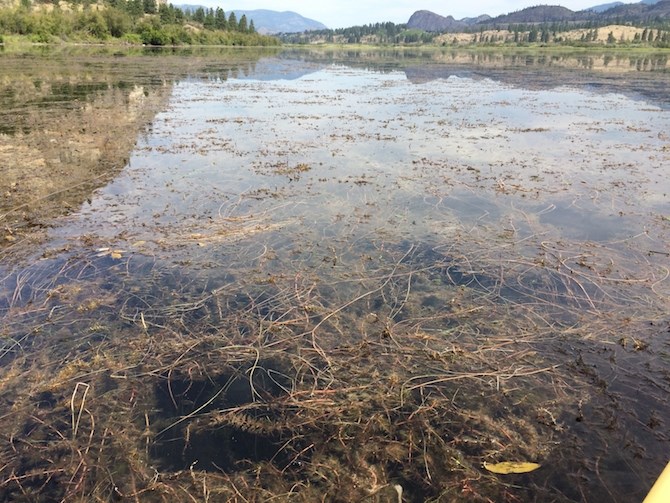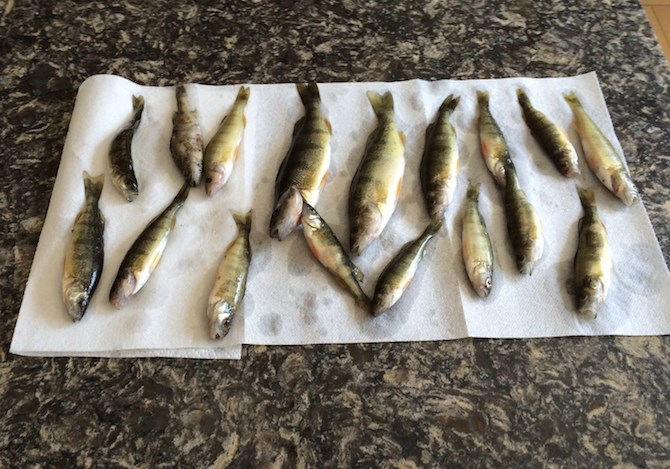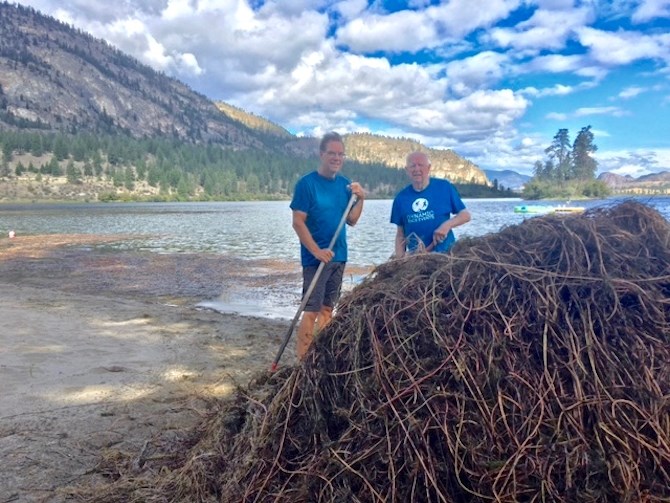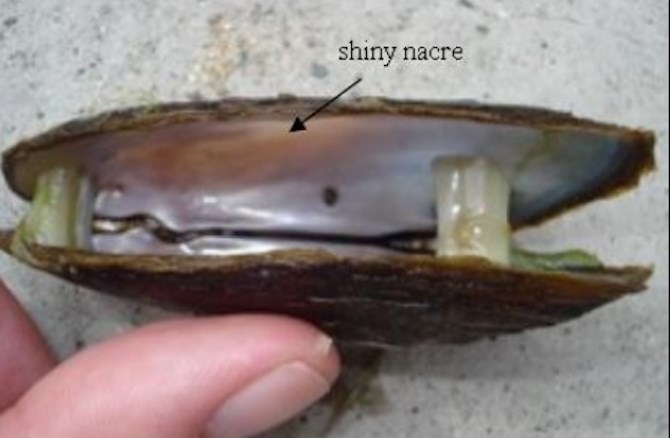
This is what the milfoil invasion on Vaseux Lake in the South Okanagan looked like in 2016.
Image Credit: Submitted by Norm Gaumont
April 18, 2019 - 6:30 PM
KELOWNA - Look no further than the dead fish washed up on Vaseux Lake beaches if you want to see the grim future of other Okanagan lakes when Eurasian Milfoil is allowed to expand.
Vaseux is a small lake south of Penticton and is the only lake in the Okanagan River chain that has never been rototilled since the milfoil spread through the Valley in the 1970s.
One of the worst years was 2016 when milfoil covered about a quarter of the lake’s surface.
“Over a two-week period, we picked up just under 100 dead fish along the southern part of our lake,” Norm Gaumont, the founder of the Vaseux Lake Stewardship Association told iNFOnews.ca.

It took Norm Gaumont only 15 minutes to collect these dead fish from in front of his Vaseux Lake home in 2016.
Image Credit: Submitted by Norm Gaumont
Then there were the massive amounts of dead milfoil that washed up during high winds and were piled on the shore, waiting to be hauled to the dump.
Vaseux is a not-too-shining example of what could happen on larger Okanagan lakes that have been rototilled for decades to control the weed.
Rototilling has been banned by the provincial government within 100 metres of any Rocky Mountain Ridged Mussel it can find.
Kin Beach in Vernon is one example of what can happen to a sandy public beach. The northwest corner has not been rototilled for five years and a ban was imposed on the rest of the beach this winter, because of the mussel.
More bans are likely to follow.
On a poster highlighting the importance of protecting the mussel, the province shows vast areas where mussels have been found. That includes the tips of both northern arms of Okanagan Lake, around the Bennett bridge in West Kelowna, most of the west side of Okanagan Lake from Summerland to Penticton, Naramata and the northern half of Skaha Lake.
“We’ve done pretty extensive surveys for mussels and rare plants and kokanee and with that data we’ve established zones on the lakes,” Lora Nield, Ecosystems Section Head in the Ministry of Forests’ Penticton office told iNFOnews.ca. “Those zones reflect the sensitivities, and therefore the practices we would allow to occur at those sites.”
Those restrictions apply to land owners who want to develop next to the lake or build docks and marinas. In some cases, they may have to relocate the mussels.
But it also allows the province to ban rototilling milfoil in the winter, which is the most effective control of the prolific weed.

Norm Gaumont(right) and his neighbour Ron Worth piled up the mifoil that drifted onto their Vaseux Lake beach in 2016.
Image Credit: Submitted by Norm Gaumont
Gaumont believes the province’s efforts are misguided, arguing that thick beds of milfoil create a couple of feet of sludge on the bottom and a depletion in oxygen levels which would not allow mussels to live there. Rototilling, he suggested, may create a better habitat for the mussels.
Gaumont and James Littley, the Okanagan Basin Water Board’s Operations and Grants Manager, argue that a lot more research needs to be done on the interaction between mussels and milfoil before rototilling is banned.
And, Gaumont said, Vaseux Lake should be used as a study area.
“Our take on it is, a proper study hasn't been done," he said. "Our lake is the perfect one to do it on because we've never been rototilled. We've looked under the beds and we've never seen Rocky Mountain Mussels."
Nield agrees more research needs to be done but believes it’s best to ban first and do the science later.
“It doesn’t mean 100 per cent no go (on Kin Beach, for example),” she said. “For this year, we say no rototilling on the rest of the beach and then figure out the long term plan.”
But, she stressed, she doesn’t want anyone to get the impression the current rototilling ban is temporary. Relocating small populations of mussels is one option but, if the rest of the beach has the concentration levels of the northwest corner, the ban could become permanent.
Studying Kin Beach and Vaseux Lake are at the top of her priority list for this year, she said.
She expects to meet soon with the Okanagan Basin Water Board to frame the questions that need to be answered, such as whether she needs to search the northwest corner of Kin Beach to see if the unrototilled milfoil has created an environment where it’s impossible for mussels to live.
“There are some unknowns about managing milfoil, the implications of oxygen levels and what-not that James Littley has started to talk about,” she said. “We don’t know the answers to those questions yet. We have more research to do on that.”
She said it’s too early to say how long such research will take or when it starts. First, she needs to sit down with people like Littley and frame the research.
In the meantime, summer harvesting of the top few feet of the milfoil is the only control that will happen at some beaches.
WHAT IS A ROCKY MOUNTAIN RIDGED MUSSEL?
The mussel is actually quite a large shelled creature, similar to what can be seen on ocean beaches.
It can grow up to 12.5 cm long, live for 60 years and may filter 40 litres of water a day.

The Rocky Mountain Ridged Mussel is native to the Okanagan. This one is from Dog Beach in Summerland.
Image Credit: From www.canada.ca
It prefers gravelly bottoms rather than sand but has been found in milfoil, which prefers a sandy bottom.
Since it usually lives in half to one-and-a-half metres of water, it can be spotted by searches on shore or by snorkeling.
In Canada, it’s only found in the Okanagan but it lives in the western United States down to southern California.
In 2005 it was listed as a species of “special concern” under the federal Species at Risk Act.
In 2010, the Committee for the Status of Endangered Wildlife in Canada, which makes submissions to the federal government, applied to have the mussel raised to endangered status. The government is, just now, considering that request, Nield said.
To contact a reporter for this story, email Rob Munro or call 250-808-0143 or email the editor. You can also submit photos, videos or news tips to the newsroom and be entered to win a monthly prize draw.
We welcome your comments and opinions on our stories but play nice. We won't censor or delete comments unless they contain off-topic statements or links, unnecessary vulgarity, false facts, spam or obviously fake profiles. If you have any concerns about what you see in comments, email the editor in the link above.
News from © iNFOnews, 2019